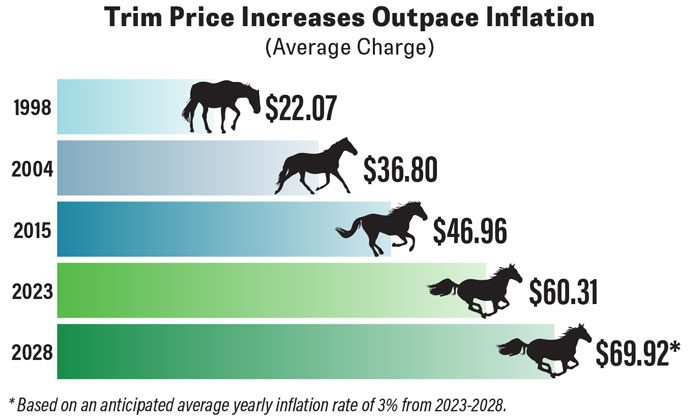Some farriers are still charging the same prices as a few years ago, ignoring continuing increases in fuel, materials, inflation and other costs. While increasing prices is a difficult aspect of running a farrier business, it’s a concern that many hoof-care professionals lose sleep over.
If you’ve wondered how you compare price-wise with other farriers with work ranging from a simple trim to more complicated shoeing jobs, here’s your chance to see how your prices compare with the low, high and average charges for 20 horses with different footcare needs. Plus, we’ll look at what a difference 25 years has made in the pricing of two basic hoof-care scenarios, along with estimates on what you should be charging 5 years from now.
Here’s Our Shoeing Scenario
The 144 full-time farriers who responded to this exclusive American Farriers Journal survey were told these 20 horses were handled under the following conditions, except for the differences noted in each description.
- The shoeing was done in a public boarding barn 15 miles from home.
- The farrier was already at this barn for a day’s work, so an extra trip wasn’t made to handle one horse.
- The barn was a middle-income operation.
- Horse values were in the $1,000 to $6,000 range.
- This was not a fancy barn, but one having a work area with a good floor and bright lights.
- Horses stand quietly in cross-ties except where noted.
- Horses were owned by individual clients except where noted.
- Owners were long-standing regularly scheduled clients, which the farrier wants to keep as valuable customers.
- Horses were shod with the style of shoes the farrier normally uses.
- Horses were short-footed, pleasure-type horses unless otherwise noted.
As one farrier points out, setting prices on many footcare possibilities helps his business structure. “With this survey, you opened my eyes to a few hoof-care procedures I hadn’t priced out, so thanks,” he writes. Another farrier adds, “This is a great way to get an average of what people charge for specific jobs and the survey is a wonderful idea.”
Prices for 20 Hoof-Care Scenarios
#1. Easy Rider
Trim only. Horse stands like a rock. Easy money.
Range: $30 to $180
Average: $60.31
#2. Barney Boarder
Trim only for barn owner. Among 10 horses you trim for the stable owner.
Range: $20 to $150
Average: $57.93
#3. Half-Wild Floyd
Trim only. Long yearling, shed-raised colt. Halter broke, but has to be held. Has not had its feet handled. Half wild, half spooky. Has long feet.
Range: $30 to $160
Average: $74.42
#4. Tweedle Dum
Trim and shoe front feet with two new shoes. Trim hind feet.
Range: $55 to $300
Average: $132.54
#5. Tweedle Dee
Trim and reset two front shoes nailed on 6 weeks ago. Trim hind feet.
Range: $55 to $450
Average: $131.00
#6. Reset Fred
Trim and reset four good shoes put on 6 weeks ago.
Range: $65 to $600
Average: $186.86
#7. Reset Ed
Trim and reset four good shoes and replace pads you put on 6 weeks ago.
Range: $70 to $475
Average: $217.90
#8. Plain Joe
Trim feet and nail on four new steel shoes of your choice for this regular boarder.
Range: $65 to $400
Average: $187.56
#9. Clockwork Tom
Trim feet and put four new shoes on this lesson horse. This is among 10 lesson horses you shoe on a regular schedule for the barn owner.
Range: $65 to $400
Average: $184.29
#10. Nervous Nellie
Trim and nail on four new steel shoes of your choice. This is the horse you would happily push over the edge of a cliff. It has to be held, won't stand in cross-ties, will bite when it can and pull its hind feet away when it wants to.
Range: $75 to $500
Average: $223.03
#11. Fancy Kristina
Trim and put two new aluminum shoes on front feet of a show hunter or pleasure show horse. Nail square-toed steel shoes on the hind feet.
Range: $$65 to $425
Average: $224.82
#12. Tender Foot Tom
Trim and put on four new shoes with pads.
Range: $85 to $475
Average: $237.79
#13. Navicular Sam
Trim and nail two steel egg-bar shoes on front and two regular steel shoes on back.
Range: $365 to $650
Average: $238.63
#14. Jumbo Jake
Trim and nail on four new steel shoes. This is a half draft horse with feet like dinner plates. He's quiet, but his feet are as heavy as a side of beef.
Range: $$65 to $700
Average: $274.49
#15. Shoeless Joe
This is a horse you shod 2 weeks ago. He's lost a shoe, the owner found it and you need to nail it back on.
Range: $5 to $75
Average: $35.00
#16. Shoeless Moe
This is a horse you shod 2 weeks ago. He's lost a shoe and the owner can't find it. Replace with another shoe.
Range: $5 to $175
Average: $41.94
#17. Shoeless Woe
This is a horse you shod 2 weeks ago. He's lost a shoe that was in the pasture. However, his foot is badly broken up and short from losing the shoe. You'll need acrylic to re-nail the shoe.
Range: $10 to $250
Average: $67.34
#18. Quarter Crack Mac
A non-bleeding, old quarter crack needs to be repaired. Acrylic, plate, screws, etc., are options. This cost does not include a charge for new shoes.
Range: $15 to $500
Average: $116.80
#19. Laminitic Larry
This is a horse with 10 days post-laminitic insult. The veterinarian wants to stabilize and protect the foot. He prescribes heart-bar shoes or full-support shoes with hospital plates.
Range: $40 to $750
Average: $280.43
#20. Barefoot Abe
This barefoot horse can't bear weight on its left front foot. There's heat in the foot, a strong digital pulse and an obvious abscess. The owner wants you to find and open the abscess. No shoeing work.
Range: $10 to $1800
Average: $57.5425
Years of Pricing Data
For these 20 horses, we used the same descriptions for comparison purposes that were part of three identical AFJ pricing surveys conducted in 1998, 2004 and 2015.
To gather the 2023 pricing information, an electronic survey was sent to full-time farriers across the country. Selected from the American Farriers Journal mailing list, each farrier was asked to indicate what he or she would charge for these 20 trimming and shoeing scenarios. Some 144 farriers completed this non-scientific survey.
Dealing with Lost Shoes
Comments from farriers who answered this survey demonstrate that there are no easy answers when it comes to dealing with lost shoes, such as with scenarios #15, #16 and #17 on sidebar above.
- A number of farriers indicated they would not charge for replacing shoes lost within 2-6 weeks of a farrier visit.
- “I replace lost shoes for free for up to 2 weeks depending on how far I have to drive. If a horse is pulling shoes on a wire fence, I charge $20 if the owner has the shoe and $30 if they do not.”
- “Resetting a lost shoe is free if I'm already at the barn, but there’s a charge for a special trip.”
- “I only charge for gas unless it’s over 4-5 weeks.”
- “I don't lose many shoes out of the 293 horses on my book and I warranty them to stay on for the length of the shoeing cycle. For a horse that is a habitual shoe puller who paws fences, I charge $50 to drive and replace the shoe.”
- “We guarantee our work for 6 weeks so there’s no charge within that time frame unless the horse is being a fool or habitually sticking a shoe in the fence.”
- “I guarantee my work if they pull a shoe within 5 weeks. Depending on how much acrylic is needed for #17, I’d charge for this.”
- “Most therapeutic work is billed at $6 per minute plus a charge for materials.”
- “I charge $150 per hour for custom work, such as rebuilding a hoof in addition to the normal shoeing charge.”
- “#17 would be an extra $50-$100 depending on the amount of acrylic used.”
Keeping Up with Inflation
Over the 25 years from 1998 to 2023, the average rate of inflation averaged 2.55% per year, as defined by U.S. Consumer Price Index data. During this time, farriers increased their average trimming prices from $22.07 to $60.31, which represents overtaking inflation by $18.92. This is a 46% increase over the average yearly 25-year inflation rate. Based on 3% inflation per year, this charge is projected to increase to $69.92 by 2028.

Over the past 25 years, these farriers have increased prices for trimming and nailing on four steel keg shoes from $69.54 to $187.56. Based on U.S. Consumer Price Index data, the increase with this price from 1998 due to inflation would only have reached $130.42 in 2023. This represents a 44% increase over the average yearly 25-year inflation rate of 2.55%. Source: American Farriers Journal Survey
At the same time, farriers boosted the average price for trimming and nailing on four steel keg shoes from $69.54 to $187.56, outpacing inflation by $57.14. This is a 44% increase over the average yearly 25-year inflation rate of 2.55% rising to $217.43 within 5 years.
Learn More Online
Gain more insight on pricing your services by reading:
Between the 2015 and 2023 surveys, the largest increase of $52.09 occurred with trimming and nailing on four new steel shoes for “Nervous Nellie." What’s interesting with this #10 scenario is that farriers want considerably more dollars for handling a horse that had not been properly trained to stand for footcare work by the owner.









Post a comment
Report Abusive Comment